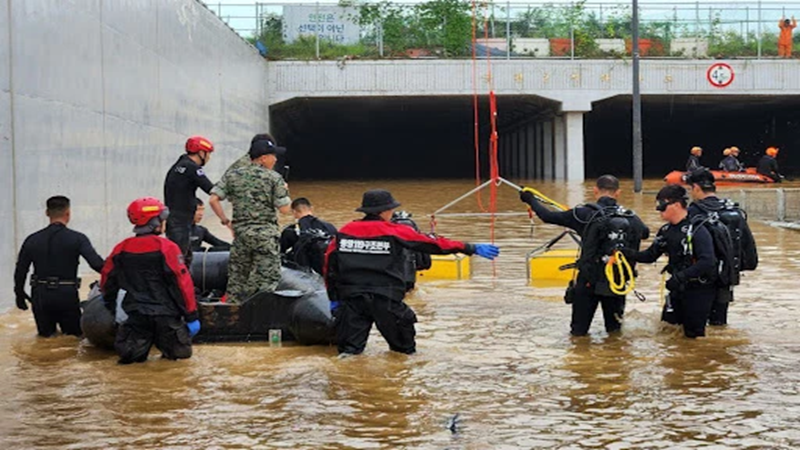
Suhayfa Sheik
South Korea's floods: root causes and prevention strategies.
Most Read Stories Today
-
Water Scarcity and Artificial Rainfall: The Positive and The Negative Effects of Cloud Seeding, including Health Hazards and Climate Implications.
-
Renewable Energy in Rural Areas: Challenges, Opportunities, and Successful Rural Projects
-
Pakistan's Agriculture at Risk Due to Climate Variability
-
South Africa's Recent Floods: Is Climate Change to Blame?
-
South Korea's floods: root causes and prevention strategies.
-
South Africa: Cape Town, A City Under Fire
-
The Human Cost of Climate Disasters
-
Our Oceans, Our Future: The South African Dilemma of Overfishing
-
Degenerative Impact of Hydrocarbons On The Environment.
-
Sustainable Urban Planning - Copenhagen and the Path to Climate Resilience
Natural disasters not only endanger human safety, but their severity has also resulted in unprecedented losses. Due to the consequences of global warming and climate change, natural disasters are becoming more severe and frequent while the winter is becoming colder and the summer is becoming warmer.
Typhoons, heat waves, heavy rain are regularly experienced in Korea and significant snowfall frequently occurs during the winter. They often have negative repercussions on Korea. Typhoons and heavy rains are the two most dangerous natural disasters in Korea. Floods and typhoons claimed a great deal of lives between 1984 and 1990.
In 1984, there were approximately 360 000 flood casualties in the region of Seoul and Gyeonggi-do. Global warming and climate change has resulted in a worsening of heavy rainfall. Seoul saw its worst flood on August 8, 2022 due to the greatest rains in 115 years. Extreme rains and loud thunders flooded numerous homes, businesses, subway stations, and streets, leading to outages for hours.
Numerous individuals were evacuated to safer locations as a result of the flooding, which caused landslides in high lying areas and stranded several commuters in floodwaters on their way home. The most affluent neighbourhood in South Korea, Gangnam, lost expensive stores and opulent homes to the natural disaster. The poorer areas of Seoul lost their homes due the flooding caused by the natural disaster. When there were no formal instructions and precautionary actions immediately following the disaster, citizens were upset.
This wasn't the first time Seoul had to deal with severe rain. There was a catastrophic landslide that killed approximately 18 people in the Gangnam district eleven years ago that was significantly worse by following rains and floods. Despite Seoul's frequently occurring natural disasters, funding for flood prevention was reduced. The odd weather and torrential rain in August were caused by climate change, as stated by the Korea Meteorological Administration, and South Korea has just recently started to see its impacts.
To properly prepare for big disasters in the future, safety management standards must be significantly improved and firmly reorganized. A separate disaster zone is being created by the government for the districts affected by the recent severe rains. We need to develop additional necessary climate change mitigation strategies, such as improved weather forecasting, promotion of renewable energy, and renovation of buildings to increase energy efficiency. As forecasting technology has advanced over time, they have become more important in planning for and reducing the effects of natural catastrophes.
Greater public awareness of natural disasters can reduce the number of fatalities, missing individuals, and victims. As a result, we are now better able to prepare for these scenarios. Only long-term preventative measures and a goal of carbon neutrality will save Koreans from further downpours. Governments at the municipal, state, and federal levels can work together to reduce risk. The Korea Meteorological Administration (KMA), which offers early warning, short- to medium-range forecasting, and long-range climate change projections, is crucial to aiding catastrophe mitigation.
It is in the process of enhancing meteorological observation systems to further enhance these services. For instances of heavy rain, snow, storm surges, tsunamis, typhoons, yellow dust, and other extreme phenomena, KMA publishes warnings and special weather reports. For the purpose of reducing the risk of flooding, maintaining urban drainage and water management systems is considered to be crucial.
Another important component of the Korean strategy for fostering resilience is community-based preparedness, which takes climate information right into people's homes. Teams of community volunteers for disaster prevention should be created. It is evident from the experience of Korean cities and communities that a co-operative culture is necessary for disaster risk reduction and prevention.
In order to achieve this, it is necessary for community organizations, civic society, women's and youth's organizations, academic and technological institutions, and the commercial sector to collaborate.

Terms & Conditions
Subscribe
Report
My comments